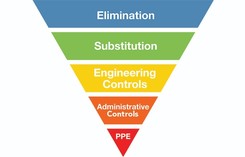|
HSE is inspecting fabricated metal businesses across Great Britain during May to check that they are managing the respiratory risks of welding fumes and metalworking fluids.
The results from last year's campaign demonstrated that LEV and RPE were being used to control exposure limits. Figures showed that:
- 70% used LEV as a control measure, either as a sole control measure or along side RPE
- 80% of those using moveable capture hoods were found to be performing well
- RPE results showed 78% of sites were using RPE, however only 50% of tight-fitting respirators were being used correctly
While these figures show promising results, improvement is needed. The aim of this bulletin is to gain more understanding of both LEV and RPE, and to ensure they are being used correctly.

In line with COSHH regulations and the hierarchy of control, workplace exposure should be prevented by avoiding the use of the hazardous substance.
If this cannot be done, exposure should be minimised by modifying the process and/or applying engineering controls, such as enclosure and/or LEV.
Only where adequate control of exposure cannot be achieved by these means alone, should RPE be used in addition to these measures to control the remaining or residual risk.
|
LEV is an engineering control used to reduce the risk of inhalation of substances hazardous to health in a workplace, such as dust, gas, mist, fume or vapour.
Typically, these substances may cause respiratory diseases such as occupational asthma, cancer and chronic obstructive pulmonary disease (COPD).
LEV systems perform an essential function to protect health. They must be properly designed, installed, commissioned, tested and maintained to be effective. It is essential that employers use competent LEV engineers.
Further information is available on our LEV website and in the publication Controlling airborne contaminants at work: A guide to local exhaust ventilation.
Using suitable RPE for welding fume
If you cannot achieve adequate control from LEV alone, or if it is not reasonably practicable to provide LEV, you must provide your workers with suitable RPE.
For example, LEV may not be capturing all of the fume. If this is the case, you are not controlling the risk and you should also provide RPE.
Fit testing
If RPE is used to control exposure to substances hazardous to health, it should be suitable for purpose - this includes consideration of the fit to the wearer. Results from last year show only 49% of wearers were face fitted when required.
Information on types of RPE can be found in the publication Respiratory protective equipment at work: A practical guide.
When providing RPE for your workers:
- use tight-fitting FFP3 disposable mask or half-mask with P3 filter for work of up to one hour
- use battery-powered air-fed protective equipment for longer duration work, with a minimum assigned protection factor of 20 (APF20)
Face-fit testing should be carried out if choosing tight-fitting RPE. This is because tight-fitting respirators depend on achieving good contact between the wearer’s skin and the face seal of the RPE.
Fit tests should not be conducted if there is any growth between the wearer’s skin and the face-piece sealing surface such as stubble growth, beard, moustache, sideburns or low hairline. Any facial hair will make it impossible to get a good seal of the mask to the face.
It is also very important that RPE is put on correctly and checked for a good fit every time. Being clean-shaven when wearing tight-fitting RPE will help prevent leakage of contaminated air around the edges of the RPE and into the lungs.
For welding outdoors, LEV will not work, so workers should use suitable RPE to control exposure.
You should always provide appropriate:
Further information and tools to help employers select and manage the use of RPE in the workplace can be found on our RPE website.
At a recent inspection of a manufacturing site, a HSE Inspector identified that a paint spray booth was being used to control isocyanate-contained paints. Isocyanates are respiratory sensitisers and can cause occupational asthma.
The LEV Thorough Examination and Test (TExT) report for the paint spray booth did not meet the requirements detailed in Paragraphs 185-189 of the COSHH Regulations Approved Code of Practice.
The service provider that undertook the TExT work had not provided their service engineers with any formal training, nor did they have any relevant qualifications in relation to the conducting of TExT on LEV systems.
Consequently, the Inspector served an Improvement Notice on the service provider in relation to their lack of competence to undertake TExT on LEV systems. The service provider complied with the Improvement Notice by stopping the undertaking of this type of work directly and sub-contracted any future TExT work to companies that employed externally-trained engineers with appropriate qualifications.
Enforcement action was also taken regarding the manufacturing site's dutyholder to ensure that a competent person was appointed to perform a TExT to establish that their LEV systems effectively control exposure isocyanates.
For further detailed information and guidance visit our LEV guidance, which also includes answers to frequently asked questions.
|